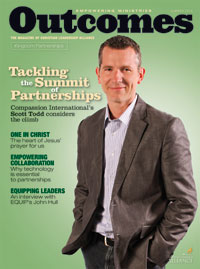Article
06
Jul
3 Questions About Networks You Always Wanted to Ask
- By Vision Synergy
Editor’s note: This was originally published on a blog by our friends, ChinaSource, on July 5, 2017.
Whether it’s outreach to Chinese studying abroad or equipping a new generation of Chinese Christians to serve cross-culturally, some tasks are simply too big for any one organization, no matter how well-run or well-resourced they may be. These efforts require a network of likeminded groups, all working from their respective strengths in pursuit of a common goal. Here Kärin Butler Primuth, CEO of visionSynergy, discusses the characteristics of high-impact networks.
1. Why, and when, are networks needed?
Networks are needed when organizations go after a God-sized goal that is larger than any one of them, but which aligns with the purpose of each one. It’s the purpose that keeps them moving in the same direction, working together toward that shared goal. What’s especially important is that the purpose is clear and compelling. It must be clear so each agency or person knows what they can contribute and potentially gain by participating. It must be compelling so people are motivated to invest their limited time and will keep investing in the face of challenges or limited progress.
2. Who makes the network happen?
Networks are all about the people in them. Ideally these should be the ones who are the most influential, most interested, and most involved in whatever sphere the network is working. But they know they cannot do it by themselves. The network provides a place to share information and explore potential collaboration. It facilitates their secure communication. The way people work together is vital to the success of any network.
To achieve this requires leaders who are competent, called, and committed to the shared goals, able to cross theological divides, and build consensus among people who may be very different. The qualities desired in network leadership are not the same as organizational leadership. Network leaders appreciate and creatively build on the gifts and vision of others rather than trying to control the process. They focus on what unites, rather than what divides, and work to build a culture of trust where all voices are heard and valued.
3. How do you get from vision to reality in a network?
The process transforms vision into action, generating activity by setting clear, limited goals that are achievable. It develops structures for planning and decision making, providing clear opportunities for involvement. It takes time to evaluate what’s happening and, finally, to celebrate progress. Each of these steps is necessary for the development of a healthy and effective network which, when empowered by God’s Spirit, can achieve far more than any individual or organization can accomplish on their own.
19
May
A Different Kind of Leader
- By Vision Synergy
The network leader is one of the fastest-emerging and most critical leadership roles in ministry and mission today. Networks — not agencies — are now shaping highly important mission and ministry strategies. Networks and their consultations are fast becoming the main gathering points for Christian leaders from around the the city to around the world. In them, Christians connect, share information and resources, establish standards, and collaborate with one another for greater impact.
We must understand the distinctive role of the network leader who leads these relatively new forms of organizing. This role sometimes goes by other terms — network facilitator, system leader, association or alliance leader, network coordinator — but this article will use the broad term of network leader.
Networks are not institutions
“Networks are not institutions, they cannot be expected to do what institutions do,” says A.K. Bernard. Nor can networks be led as if they were organizations or institutions. In fact, networks and partnerships operate so differently from traditional organizations that they can easily fail if traditional leadership strategies are used. These differences drive the need for a different kind of collaborative leader with unique skills and ways of working.
Many ministry leaders newly assuming collaborative leadership roles discover they are ill-equipped to lead a complex network. They have never had training or experience facilitating a large set of organizations as it develops commonly-shared goals resulting in significant action. Additionally, many have not received mentoring, coaching or advising from experienced network leaders.
Recognizing the Gap
Today’s increased demand for networks has uncovered a deep gap in training, mentoring and coaching for people who want to develop enduring and effective mission networks. These differences demand a different kind of collaborative leader with specialized skills for “the network way of working,” as the Network Leadership Training Academy terms it.
Perhaps it is not obvious to traditional leaders that interorganizational leadership calls for a new set of skills and approaches. An organizational leader, we often assume, ought to easily transition to leading a network of organizations. But the reality is often very disconcerting as they realize that interorganizational leadership calls for a different set of skills and approaches. “Many organizations are finding it challenging to adopt a network approach to leadership, and leadership programs are not supporting organizational leaders to develop those skill sets,” says network analyst Claire Reinelt.
12
Oct
What’s getting in the way? The Five Greatest Roadblocks to Engagement
- By Vision Synergy
 The world is a big, complicated place.
The world is a big, complicated place.
The Muslim world is a 1.5+ billion person segment of that world with significant Muslim populations stretching from West Africa to the southern Philippines. With its heartland in the Middle East, where all history began and where it will all end, for political, economic, and deeply spiritual reasons, engaging the Muslim world effectively with the transforming message and power of the Lord Jesus must be a very high priority.
Christian leaders worldwide agree that today is a day of unparalleled opportunity in unleashing the gospel throughout the world. The global Church has never had more resources than she has today. However, despite serious and often sacrificial efforts to realize this vision, we’re far short of achieving our goals. With 1177 Muslim Unengaged Unreached People Groups (MUUPGs) — 187 of them over 100,000 in size—the task ahead of us is formidable. [1]
One of the global networks we serve – which is made up of 135+ organizations from 25 sending nations – has a vision to see effective church planting among all Muslim people groups, and we have set engagement of MUUPGs to be a top priority.
In April 2012 a survey was conducted of the network which asked the single question:
24
Sep
Increasing Mission Effectiveness Through Partnership
- By Vision Synergy
 Increasing Mission Effectiveness Through Partnership is a new article from visionSynergy CEO, Kärin Primuth.
Increasing Mission Effectiveness Through Partnership is a new article from visionSynergy CEO, Kärin Primuth.
The article was just published in eXcelerate Magazine, produced by Missio Nexus – an umbrella association of nearly 200 North American mission agencies and churches which have collectively deployed 35,000 evangelical missionaries around the world.
In the article, Kärin recounts her first time attending the North American Mission Leaders Conference hosted by Missio Nexus:
“As a new mission executive, I had the unique opportunity to sit with many seasoned leaders and ask a lot of questions. One of the things that stood out to me in these conversations was how many mission executives articulated similar organizational priorities, yet had limited, if any, intentional partnering initiatives. … The more I listened, the more convinced I became that collaboration is now essential for good stewardship of limited Kingdom resources in our increasingly interconnected world.“
Kärin goes on in the article to highlight different ways that major mission organizations have partnered together in the past few years. She concludes:
“When we set our eyes on building the Kingdom of God, rather than building our own organizations, we will discover that we have so much to gain from partnering with one another.“
Download the article
Download the entire issue of eXcelerate Magazine
23
Sep
Bridging the Divide
- By Vision Synergy
 This past week, visionSynergy participated in the Missio Nexus 2012 North American Mission Leaders Conference where one of the major workshops was focused on the theme of contextualization in Muslim ministries. The workshop was presented by members of the Bridging the Divide consultation, which visionSynergy senior advisor, Dave Hackett, has helped facilitate for the past two years.
This past week, visionSynergy participated in the Missio Nexus 2012 North American Mission Leaders Conference where one of the major workshops was focused on the theme of contextualization in Muslim ministries. The workshop was presented by members of the Bridging the Divide consultation, which visionSynergy senior advisor, Dave Hackett, has helped facilitate for the past two years.
Over these two years, the Bridging the Divide consultation has brought together numerous professors, translators, missiologists, funders, and leaders of evangelism and church planting ministries among Muslims, including a number of believers from Muslim backgrounds.
The purpose of the consultation was to address highly-charged controversies around contextualization in Muslim outreach, and in particular what is known as the “Insider Movement.” Read more…
01
Jul
A Lifelong Journey
- By Vision Synergy
 Phill Butler, visionSynergy founder, was recently asked by the Christian Leadership Alliance to write up a brief personal reflection on the past three decades of his work in building Kingdom partnerships for global mission. The Alliance published Phill’s reflection under the title, A Lifelong Journey, for the summer 2012 edition of their national magazine – Outcomes.
Phill Butler, visionSynergy founder, was recently asked by the Christian Leadership Alliance to write up a brief personal reflection on the past three decades of his work in building Kingdom partnerships for global mission. The Alliance published Phill’s reflection under the title, A Lifelong Journey, for the summer 2012 edition of their national magazine – Outcomes.
This edition of the magazine was focused on the theme of partnership and includes a number of excellent articles on partnerships in ministry and mission.
Among these were:
Tackling the Summit of Partnerships
by Scott Todd
One in Christ
by John G. Fix
Empowering Collaboration
by Joseph Vijayam
Seven Principles for Successful Collaboration
by Doug Wicks
Down with Teamwork!
by Doug Mazza
The Critical Shift
by James Lewis
… and more.

